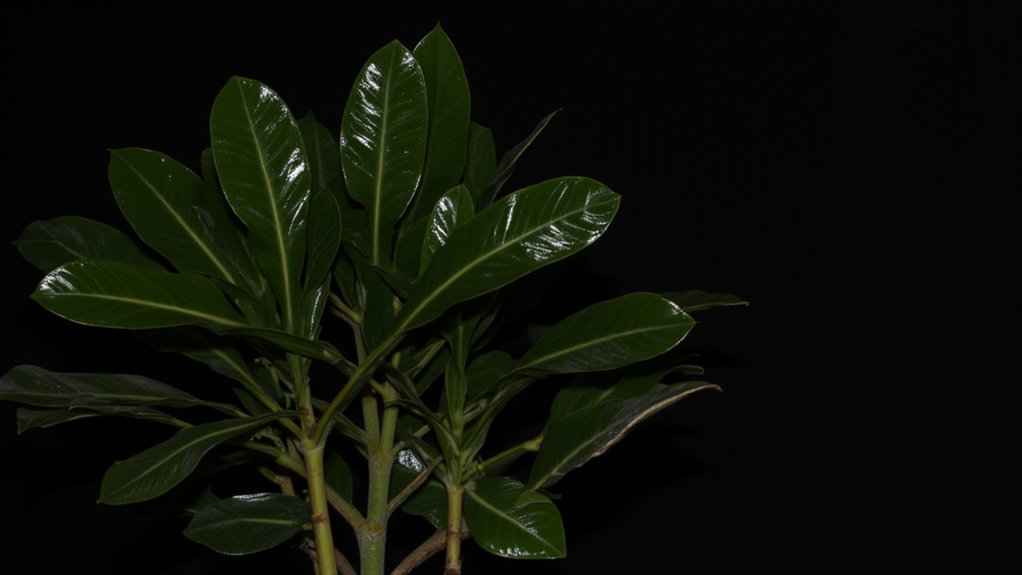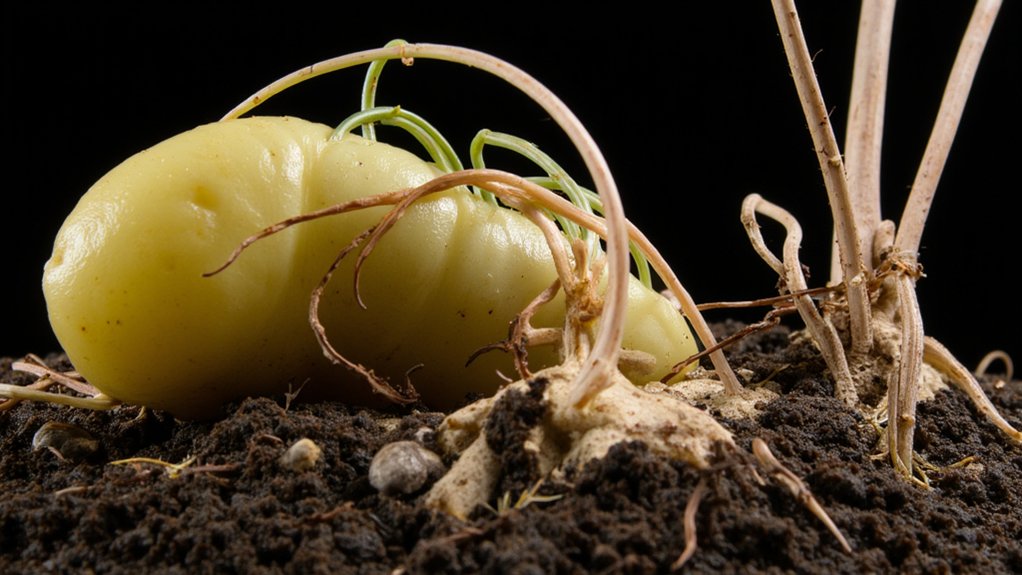You might think neglecting your houseplants is a recipe for disaster, but ZZ plants break all the rules. These resilient beauties have evolved remarkable survival mechanisms, including thick rhizomes that store water for months and waxy leaves that prevent moisture loss. While most plants demand weekly care, your ZZ plant’s sophisticated adaptations mean it can thrive with minimal attention—though there’s more to this survival story than meets the eye.
Contents
- 1 The Evolution of ZZ Plant’s Survival Mechanisms
- 2 Understanding the Water-Storage Rhizome System
- 3 Natural Defense Against Common Plant Problems
- 4 Low Light Adaptation and Growth Patterns
- 5 Optimal Growing Conditions vs. Survival Mode
- 6 The Role of Dormancy in ZZ Plant Resilience
- 7 Common Misconceptions About ZZ Plant Care
- 8 Signs Your ZZ Plant Is Actually Struggling
- 9 Best Practices for Long-Term ZZ Plant Success
The Evolution of ZZ Plant’s Survival Mechanisms

While many houseplants struggle to survive in low-light conditions, the ZZ plant has evolved remarkable adaptations over millions of years in Eastern Africa’s dry forests. You’ll find thick, potato-like rhizomes beneath the soil that store water and nutrients, allowing the plant to thrive for months without water.
The plant’s waxy, dark green leaves aren’t just for show – they’re designed to prevent water loss and protect against drought. You can spot these evolutionary advantages in the ZZ’s stems too, which are unusually thick and flexible, helping the plant conserve energy during long periods without light or water.
Understanding the Water-Storage Rhizome System

The underground rhizome system of a ZZ plant acts as its personal water bank, storing moisture and nutrients for months at a time. These potato-like structures can expand up to 4 inches in diameter, allowing your plant to thrive even when you’ve forgotten to water it for weeks.
You’ll know your ZZ’s rhizomes are healthy when they feel firm to the touch. If you’re repotting, you’ll notice these plump, cream-colored organs clustered beneath the stems. Don’t worry if they’re slightly exposed at the soil surface – that’s perfectly normal, though you’ll want to keep them mostly buried.
Natural Defense Against Common Plant Problems

Because ZZ plants have evolved robust natural defenses, you’ll rarely encounter serious pest or disease issues. Their thick, waxy leaves naturally repel most insects, while their drought-resistant nature helps prevent root rot and fungal problems.
If you notice yellow leaves, don’t panic – your ZZ plant’s self-pruning mechanism allows it to shed older foliage. The plant’s rhizomes also contain chemical compounds that deter hungry pests, making it naturally resistant to common invaders like spider mites and mealybugs.
Check once monthly for any discolored spots or leaf damage, but you’ll find these resilient plants typically correct minor issues on their own.
Low Light Adaptation and Growth Patterns
Just as ZZ plants excel at defending themselves naturally, they’ve also mastered the art of thriving in dark corners. Their thick, waxy leaves contain specialized chlorophyll that efficiently captures even minimal light, allowing them to photosynthesize in conditions as low as 50-100 foot-candles.
You’ll notice your ZZ’s growth patterns adapt to low light situations. Instead of reaching for light sources, they’ll grow more slowly and compactly, developing darker green foliage. Their rhizomes store extra energy, enabling them to survive weeks without bright light.
In shadowy spots, expect new stems to emerge every 3-4 months, rather than monthly as they would in brighter conditions.
Optimal Growing Conditions vs. Survival Mode
While ZZ plants readily survive in low light, they’ll truly flourish under perfect growing conditions of 200-400 foot-candles with filtered, indirect sunlight. You’ll notice faster growth, more stems, and lusher foliage when providing ideal care versus basic survival conditions.
In survival mode, your ZZ plant will grow at roughly half its potential rate, producing smaller leaves and fewer new shoots. However, when given bright indirect light, consistent 65-75°F temperatures, and monthly feedings during growing season, it can generate 2-3 new stems every few months.
The key difference lies in rhizome development – ideal conditions allow the underground storage system to expand robustly, fueling more vigorous above-ground growth.
The Role of Dormancy in ZZ Plant Resilience
Although ZZ plants maintain their striking appearance year-round, they’ll naturally enter periods of dormancy when growth slows considerably. During winter months, your plant will shift into a protective state, reducing water and nutrient uptake by up to 80%.
You’ll notice this dormancy phase when new growth stops and older leaves might yellow slightly. Don’t worry—this is perfectly normal. Instead, reduce watering to once every 4-6 weeks and skip fertilizing entirely.
This survival mechanism allows ZZ plants to conserve energy through harsh conditions, much like their native African habitat’s dry season. They’ll resume active growth when temperatures rise above 65°F.
Common Misconceptions About ZZ Plant Care
Despite their reputation as indestructible houseplants, ZZ plants aren’t actually immortal or completely maintenance-free. Many people mistakenly believe they never need water, can survive in zero light, or thrive in direct sunlight. These myths can lead to plant damage.
You’ll often hear that ZZ plants grow quickly, but they’re actually slow growers, typically producing only 2-3 new stems annually. Another common misconception is that they need fertilizing monthly, when they only require feeding 2-3 times during the growing season.
The belief that ZZ plants purify air better than other houseplants is also overstated. While they do filter some toxins, their air-cleaning abilities are modest.
Signs Your ZZ Plant Is Actually Struggling
A struggling ZZ plant sends clear distress signals that you’ll need to recognize quickly. Watch for yellowing leaves, which often indicate overwatering, or brown, crispy leaf edges that suggest underwatering or excessive direct sunlight.
If your plant’s stems are becoming soft and mushy at the base, you’re likely dealing with root rot. Meanwhile, leggy growth with wide gaps between leaves means your ZZ isn’t getting enough light, though dropping leaves can signal either too much or too little water.
Black spots on leaves usually indicate fungal issues, while curling leaves often mean your plant’s getting too cold or experiencing draft exposure.
Best Practices for Long-Term ZZ Plant Success
Since maintaining a ZZ plant’s health requires consistent but minimal care, you’ll want to establish a few key routines for long-term success. Water only when the top 2 inches of soil feel completely dry, typically every 2-3 weeks, and guarantee your pot has proper drainage holes.
Position your ZZ plant in low to moderate indirect light, about 3-6 feet from windows. While they’ll tolerate darker spots, avoid direct sunlight that can scorch their leaves. Maintain room temperatures between 65-75°F.
Fertilize lightly with a balanced 10-10-10 solution once every 3 months during growing season, and repot only when roots become severely cramped, usually every 2-3 years.
